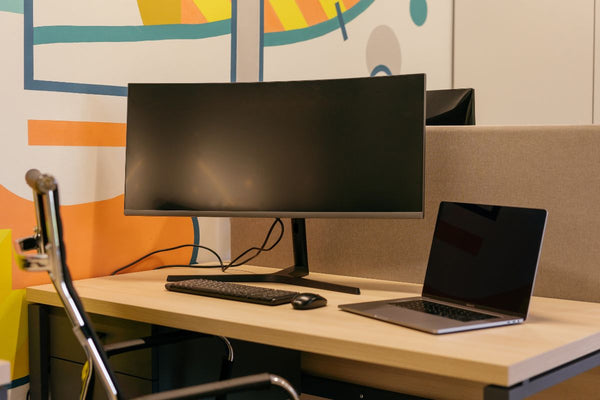How to Enable Remote Work in Any Organization: The Complete Guide to Follow
 Mara Quintanilla
Mara Quintanilla
At the start of 2020, companies were forced to adapt to remote work. While only a few had already been enabling remote work, the pandemic skyrocketed the number of workstations that had to be set up or adapted at employees' homes. Some companies adapted quickly to the changes, whereas others struggled with the challenge of managing a distributed workforce.
Before the pandemic, only 20% of employees were working remotely. After the outbreak, 71% of employees were working from home, according to a survey by Pew Research Center. In that same research, 54% of workers stated that they would like to continue working remotely after the end of the pandemic.
As companies adjust to the new workforce dynamics, many realized that remote work is beneficial for their employees. Working from home can help increase productivity, decrease stress and save money on office space. But how can a company make the move to a distributed arrangement? What needs to be considered and how can employees follow the process seamlessly?
The first thing is to provide employees with the same tools they would have in an on-site office. This means that they need access to computer equipment and platforms that the company uses. At the same time, organizations must provide the necessary security and compliance policies to ensure that the devices are used properly and data stays safe.
In terms of day-to-day tasks, having the appropriate channels for communication is paramount for teams to work successfully. Precise and efficient communication helps to keep your remote teams productive by outlining exactly what needs to be done.
Essential steps to enable remote work in your organization
If your company is ready to go remote or is just looking to stay updated on best practices for distributed teams, here are the seven essential steps that managers should consider for their remote work strategy.
1. Plan for remote onboarding and training
Before you begin, it's important to have a clear onboarding plan and to train new hires or employees transitioning to a remote arrangement. Without this, you risk losing valuable time and money on the hiring process and could end up with a team that isn't well-trained or familiar with the company culture.
Creating a comprehensive onboarding process can help ensure you're able to meet your goals and keep your remote teams productive from day one. The best way to approach this is by creating a work-from-home onboarding checklist that outlines all of the policies and procedures that new hires need to know about to start their jobs. This should include things like:
- Home office safety to eliminate potential hazards.
- A management structure that outlines everyone’s duties and working hours.
- A communication structure that allows employees to do their job.
- Company and employee objectives that need to be achieved.
- Detailed workflows and processes that should be followed.
2. Establish and share role objectives, KPIs, and clear responsibilities

New hires or employees that are going remote for the first time need guidance on what is expected from their role and how they should carry it out. Establishing clear objectives and responsibilities, as well as metrics can help both employees and employers to understand how to measure performance.
When all these elements are in place, both parties can work together to achieve their goals. You also need to provide regular feedback so employees can stay on track with their goals and see if any adjustments need to be made along the way. Here are some tips to set objectives and KPIs.
- Understand what the role is expected to achieve. This requires you to be clear on the function of your job and why it exists in the first place.
- Set a KPI or metric of success for your role. How will you know if you’re doing well? What sort of results should be expected at least once a quarter? Make sure this ties into what’s important for that particular team or department and how they contribute to company goals.
- Establish clear responsibilities. This will help establish clear expectations for how people need to perform their jobs and what they should be responsible for doing at any given moment.
- Set clear boundaries. People need to know where their responsibilities end and others begin so they can focus on what they’re supposed to do without feeling like they’re stepping into someone else's work.
3. Develop a suitable communication plan
Establishing a regular communication plan is essential to working effectively in a distributed workforce. One of the challenges of remote work is that coworkers are not right there beside you to ask them questions. That's why communication tools are essential, but depending on the nature of your business and its needs, these can range from chat apps to video conferencing. Some of the most commonly used communication tools are:
- Slack for text-based conversations
- Google Meet, Skype, Zoom, or Microsoft Teams for voice calls
- Monday, ClickUp, Trello, or Asana for project management
Other communication strategies can include having clear deadlines in all written communication. This will help employees know when their response is expected. You can also set up a system for checking in with your team on how things are going and giving them feedback. This is especially important if you have remote employees who work asynchronously.
As for video conferencing, it is important to have productive meetings that improve team collaboration not slow it down. For virtual meetings, it is a good practice to send out meeting guidelines and an agenda in advance. It is also important to invite only those team members who need access or have crucial information that needs to be shared with the group.
4. Get the right equipment

The type of equipment your remote workers need depends on the work they do. However, you should have an IT onboarding checklist to simplify the process of providing equipment to your employees. Equipment should include computers, phones, tablets, and other devices. Make sure they are up to date, compatible with the software you use and compatible with the software your team members use.
Make sure that the equipment is secure by installing all necessary software and security measures. Your computers and laptops should have anti-virus software, data encryption, and password protection. Phones and tablets should be password protected as well. You may want to consider installing additional security apps on mobile devices.
Some employees may already have a laptop or smartphone. If they use their equipment, make sure to have a Bring Your Own Device policy to avoid leaking sensitive or confidential information regarding your business. A mobile device management software can also help to keep devices safe.
5. Ensure security for your distributed team's equipment
As you build out a remote work model, cyber security becomes a major concern. A variety of tools can be used to ensure the safety of your employees' computers and mobile devices, but here are some of the basic tools you should consider:
- A browser that won't store browsing history, cookies, or cache.
- An email client that encrypts all messages and attachments, including images and videos.
- A chat tool that offers end-to-end encryption.
- Cloud storage that offers zero-knowledge encryption and end-to-end security.
- File-sharing tools that integrate with your messaging app or email client so only specific people have access to what they're working on.
- Mobile device management software that lets you monitor and manage mobile devices in your organization.
6. Build trust with your team
Trust is the foundation of remote work and it is built through consistent and transparent communication. If you want to enable your employees to work remotely, you need to build their trust with clear expectations, honest feedback, empathy, and respect. This will allow them to feel valued by the company which means they are more likely to do well in their role as well as be satisfied overall.
A strong remote work culture places trust as one of the most important aspects of all interactions. If you want to build a successful remote team then you need to create an environment where people can grow, learn new skills, and be challenged every day.
A remote-friendly culture is more than just having the right tools and technology in place; it’s about creating an environment where people can thrive regardless of whether they are physically present. A safe work environment promotes a culture where employees feel comfortable taking risks, innovating, and being creative.
7. Provide opportunities for connection

Remote working can make you feel lonely or isolated if you don't have connections with other people from your company. You can combat this by providing tools and structures that allow your team members to connect in person or over video chat.
Without the usual office gathering spaces for social interactions throughout the day, it is necessary to devise a plan to carry out activities where team members can get to know each other better. You can start by hosting a virtual company-wide meeting so that you can talk about your team's progress or any challenges that need to be addressed.
The key is to make sure that you're still able to build relationships with the people on your team even though they are working remotely. A healthy work culture can help your employees grow and feel satisfied with their jobs. This will make your company more productive, which in turn leads to growth.
Conclusion
A remote work culture requires a lot of effort, but it is well worth the investment. Remote work can offer benefits to both your employees and your business alike. However, implementing a remote work policy has its challenges — especially when it comes to getting everyone on board with this new structure. The key is not only planning for these challenges ahead of time but also making sure that you have all the tools necessary for success.
This means having a plan for onboarding, training and development, communication and collaboration tools, as well as the right security measures. With the right tools in place, you can create a remote work culture that benefits both your employees and your business.
GroWrk can provide your team with the equipment they need no matter where they are located in the world. Our platform can automate all your company’s IT and equipment and compliance needs across more than 150+ countries. Set up and onboard new hires to scale your business globally. Request a demo to start growing your distributed workforce across the globe.






